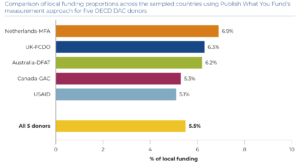Are donors delivering on local funding promises? Not yet.
The localisation of humanitarian and development assistance has become an increasingly prominent priority in global aid discourse. Donors have made repeated pledges to shift more power and resources to local organisations, recognising that sustainable, equitable development must be led by those closest to the challenges. But how much progress has actually been made?
Today, we are launching Metrics Matter III: Counting Local, the third instalment in our Metrics Matter research series tracking direct funding to local organisations. Our findings reveal that despite strong rhetoric, donor funding practices have yet to meaningfully reflect the localisation agenda.
What was included?
Using a consistent and independent methodology developed by Publish What You Fund, our research assessed the proportion of direct funding to local organisations. This was achieved by analysing disbursement data published to the International Aid Transparency Initiative (IATI) Standard from five major donors which are important voices in the locally led development space: Australia (Department of Foreign Affairs and Trade), Canada (Global Affairs Canada), Netherlands (Ministry of Foreign Affairs), UK (Foreign, Commonwealth and Development Office), and US (United States Agency for International Development).
The analysis reviewed a select number of sample countries (five countries for four of the donors, and 10 for USAID), focusing exclusively on direct project-type funding that could be implemented by local actors. Countries were chosen across regions and income classifications, with preference given to those receiving higher levels of funding.
This approach gave us a clear view on how much funding is reaching local actors – without including government-to-government aid or funding channelled through international intermediaries.
We found low levels of local funding
Our analysis found that for US fiscal year 2024:
- Across all five donors, only 5.5% of project-type funding went directly to local organisations – just $287 million of the $5.2 billion reviewed.
- The Netherlands-MFA directed the highest share (6.9%), followed by UK-FCDO (6.3%), Australia-DFAT (6.2%), Canada-GAC (5.3%), and USAID (5.1%).
- Four of the five donors, with USAID as the exception, lacked clear local funding targets and used inconsistent measurement approaches in tracking processes, resulting in insufficient quality and granularity in aid data.
The findings suggest that the localisation agenda has not yet translated into significant shifts in donor funding practices. The report underscores that meaningful localisation requires more than high-level commitments.

Why this matters
At a time when global ODA budgets are being slashed, these findings raise critical questions about whether localisation is truly a priority – or just another talking point. Budget cuts are already putting pressure on essential frontline programmes and threaten the survival of vital local partners. If donors are serious about localisation, they need to back their commitments with action and funding.
Beyond the global figures, our country-level analysis shows significant variation in how and where donors support local actors. Understanding these differences is essential. Transparent country-level data helps donor teams identify barriers and opportunities, and it empowers local organisations to advocate for change.
While we cannot overlook that a variety of factors can influence where funding goes, such as donor priorities, political context, and the strength of local civil society, donors should work towards localising funding opportunities consistently across their entire portfolios.
This report highlights an ongoing lack of clarity around how local organisations are defined and measured. Without clear, consistent definitions of what constitutes “local”, and without comprehensive, comparable data on where and to whom funding flows, donors cannot be held accountable – nor can local organisations access the information they need to advocate for greater progress and fairer, more inclusive funding systems.
Join the conversation
We hope Metrics Matter III contributes to the growing momentum for more transparent, accountable, and equitable funding systems. It’s time to move beyond the commitments and start shifting the money.
Join Publish What You Fund’s event, Localisation Re-imagined: Funding for local actors in a changing aid landscape, on Wednesday 28 May 11am-12:30pm EST / 4pm-5:30pm BST, bringing together voices from local groups, INGOs, think tanks and funders to explore what next for local funding and locally led development.

